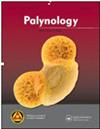葡萄牙马德拉群岛特有属的花粉形态
IF 1.3
4区 地球科学
Q3 PALEONTOLOGY
引用次数: 0
摘要
摘要本文首次报道了马德拉群岛五种特有植物的孢粉学特征:Chamaemeles Lindl, Melanoselinum Hoffm。,莫尼齐亚罗威,Musschia Dumort和Sinapidendron罗威。利用光镜和扫描电镜技术对10种特有种的花粉粒形态进行了研究。测定和描述了花粉粒的大小和形状、极轴、赤道直径和外壁纹饰。结果表明,5个特有属的花粉粒均为中等大小的单胞体。近亲蜜蜂科Melanoselinum和Monizia在极性(P)和赤道(E)直径大小和外壁纹饰上存在差异,而Sinapidendron种在P、E和P/E比值上存在差异。这两种Musschia的花粉粒非常相似,但在形态和纹饰上与Macaronesian特有的风铃花Azorina vidalii和Canarina canariensis不同。该研究揭示了特有分类群与其近缘种之间的差异,从而为以往的分类发现提供了支持。本文章由计算机程序翻译,如有差异,请以英文原文为准。
Pollen Morphology of the Endemic Genera of the Madeira Archipelago, Portugal
ABSTRACT This study presents the first palynological characterisation of the five endemic plant genera of the Madeira archipelago: Chamaemeles Lindl, Melanoselinum Hoffm., Monizia Lowe, Musschia Dumort and Sinapidendron Lowe. Pollen grain morphology of ten endemic species was studied using light and scanning electron microscopy techniques. The size and shape of pollen grains, the polar axis, the equatorial diameter, and the exine ornamentation were measured and described. We found that the pollen grains of the five endemic genera are all medium-size monads. The close relative apiaceous Melanoselinum and Monizia differ in polar (P) and equatorial (E) diameter size and exine ornamentation while Sinapidendron species show differences in P, E, and P/E ratios. The pollen grains of the two Musschia species are very similar to each other, but differ in morphology and ornamentation from the Macaronesian endemic bellflowers Azorina vidalii and Canarina canariensis. This study unveiled differences between the endemic taxa and with their close related species, thus providing support to previous taxonomic findings.
求助全文
通过发布文献求助,成功后即可免费获取论文全文。
去求助
来源期刊

Palynology
地学-古生物学
CiteScore
3.40
自引率
26.70%
发文量
48
审稿时长
>12 weeks
期刊介绍:
Palynology is an international journal, and covers all aspects of the science. We accept papers on both pre-Quaternary and Quaternary palynology and palaeobotany. Contributions on novel uses of palynology, review articles, book reviews, taxonomic studies and papers on methodology are all actively encouraged.
 求助内容:
求助内容: 应助结果提醒方式:
应助结果提醒方式:


